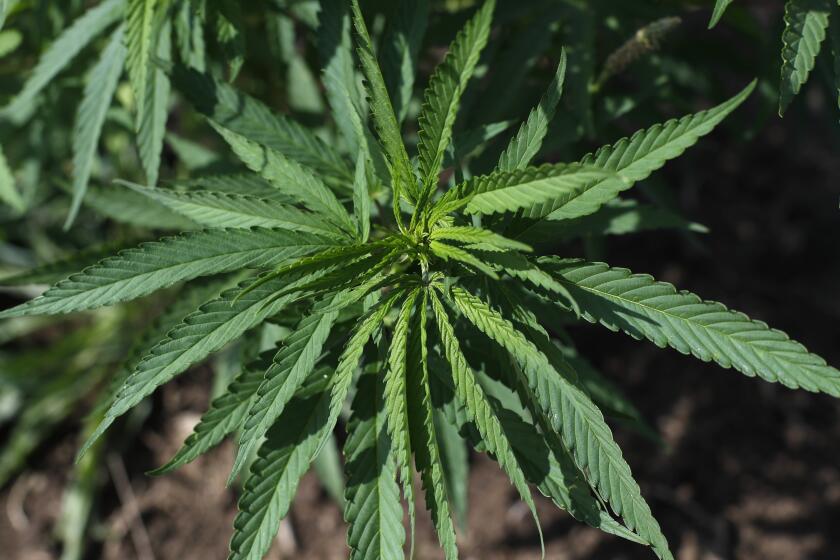DRUGS : Hawaii Drive Destroys Most of Outdoor Marijuana Crop : New type of pinpoint herbicide spraying is highly effective. State turns from a major exporter to importer of pot as prices soar.
HONOLULU â Finding 54 pounds of marijuana hidden in cardboard boxes at a busy airport is hardly unusual. What caught people by surprise was which airport: Honolulu International.
âItâs like taking coals to Newcastle,â chuckled Bill Paty, director of the state Department of Land and Natural Resources. âExcept,â he added quickly, âthis isnât Newcastle any more.â
The shipment, which arrived at Honolulu International Airport last month from Phoenix, signaled a reversal, officials say. For years, Hawaii has been a prime marijuana grower and exporter. Hawaiian marijuana, prized for its potency, is marketed across the country under names like âKona Goldâ and âPuna Butter,â after the districts where it flourishes.
âHawaii was either the largest or the second largest producer in the nation throughout the last decade,â state Atty. Gen. Warren Price said. âFor a little bitty state, we were certainly doing our share.â
No longer. A herbicide spraying program, known as Operation Wipeout, has so reduced home-grown supplies of the illicit weed that dealers have resorted to importing it. The state says it destroyed nearly 800,000 marijuana plants, worth more than $1 billion, in a six-month blitz that ended in November. That represents 80% of 1990âs outdoor crop, which was already shrunk by heavy rain, Price said.
âOur objective was to break the back of the industry, and I think weâve done that,â he said in an interview.
The key to the eradication program is a locally designed spray rig that is dangled from a helicopter. As the chopper hovers 100 feet overhead, the ball-shaped steel drum sprays each plot with glyphosate, a common weed-killer. Unlike aerial malathion spraying, which blankets large areas, the glyphosate spraying is targeted and has sparked little opposition.
âWe are looking into making that device available in other areas now that weâve used it without environmental harm,â said Stanley Morris, deputy director of the Office of National Drug Control Policy in Washington, D.C.
Although claims of Operation Wipeoutâs success are difficult to verify, the local marijuana market clearly has been affected. Marijuana, known locally as pakalolo , is so scarce that prices have skyrocketed. On the street, a pound of top-grade marijuana, which fetched $1,600 three years ago, now commands more than $5,000.
âTheyâre selling stuff they could never sell before: seeds, stems and immature leaves,â said one source. âItâs expensive and itâs no good.â
On the Big Island, whose vast tracts of undeveloped land have proved irresistible to marijuana growers, Operation Wipeout hit like âa sledgehammer,â said Roger Christie, a spokesman for the Marijuana Political Action Committee.
âSome (growing) operations have been put out of business,â he said. âItâs devastating to the local economy.â Pot cultivation, a back-yard hobby in Hawaii in the 1970s, swelled into a multimillion-dollar annual industry in the last decade. Marijuana patches as large as a quarter of an acre dotted state forests to the point where some hikers worried about encountering booby traps and armed guards in remote areas. Other growers hid their illegal crops in sprawling sugar cane fields.
Air Force reconnaissance jets methodically photo-mapped the entire state to identify marijuana plots.
The state then hired sightseeing helicopters to crisscross the islands and shoot each patch with glyphosate. The herbicide, commonly sold as Rodeo and Roundup, was spiked with red dye to let people know the plants had been poisoned.
Officials say the spray guns have pinpoint accuracy and use only a tiny fraction of the herbicide that is employed annually by state road crews and farmers for weed control. âWe were spraying marijuana in the midst of sugar cane fields, and we had people on the ground observing, and we didnât get one drop on the cane,â Price said.
About a dozen residents, mostly in rural areas of the Big Islandâs Puna district, called a state hot line to complain about helicopter noise from Operation Wipeout. Others expressed concern about herbicide drift and possible contamination of water tanks. Rona Lee Kleiman, a Pahoa resident who is chemically sensitive, said she and her family suffered from headaches and stomach problems.
âWe were poisoned,â she said in a telephone interview. âThey would spray, and then weâd get sick. Who wants to breathe this stuff in?â
But officials said they found no evidence of health problems associated with the spraying. Heartened by the results, the Drug Enforcement Administration is preparing a video for distribution to other states. It plans also to further refine the spray rig to laser-direct and videotape each spray.
Meanwhile, local officials are bracing for the next crop. âTo succeed, we have to keep up the pressure,â Price said. âThey have already begun replanting. And we will get it sprayed just about as fast as they can plant it.â
More to Read
Sign up for Essential California
The most important California stories and recommendations in your inbox every morning.
You may occasionally receive promotional content from the Los Angeles Times.










